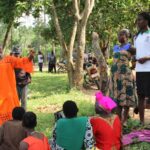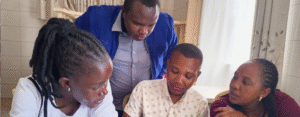
Financing Open Research for Global Development: how Africa can lead the next chapter
At the UNGA Science Summit 2025 leaders from across the world gathered to discuss a question that will shape the future of global knowledge systems: how do we finance Open Research as a global public good? A panel hosted jointly by the Science for Africa Foundation (SFA), the International Network for Advancing Science and Policy (INASP), and the UK’s Foreign, Commonwealth and Development Office (FCDO) brought together perspectives from across Africa, the UK, and global philanthropy.
Their discussion highlighted both the urgency and the opportunity of building sustainable financing models for Open Research—models that not only close equity gaps but also advance Africa’s science and development ambitions.
This blog reflects on that conversation and explores what it means for the future of Open Research financing.
What’s at stake and why the current model isn’t working
Open Research or Open Science refers to making knowledge openly available through accessible publications, data, software, and infrastructure, while promoting collaboration and engagement across society, including with indigenous and traditional knowledge systems. It strengthens policy and public confidence because decisions can be traced to open methods and data. The UNESCO Recommendation on Open Science, calls for fair and equitable systems to reduce knowledge divides and accelerate progress.
Yet the economics of today’s system still push in the wrong direction. Paying to publish Open Access (via Article Processing Charges (APCs)) has swapped one barrier for another. Major development funders spend tens of millions of dollars annually on APCs, money that often circulates back to a handful of commercial publishers rather than into shared, community infrastructure. INASP’s recent analysis urges research funders to revisit where those funds flow and what impact they achieve.
The conversation at the UNGA Science Summit identified three Open Research financing challenges that Africa must solve:
- Domestic under-investment. Many countries remain well below the African Union’s 1% of Gross Domestic Product target for research and innovation constraining both the generation of knowledge and the ability to share it openly. Open Research risks being treated as an optional add-on rather than integral part of development.
- Unequal digital infrastructure. Affordable connectivity, robust research repositories, and reliable data services are still unevenly distributed widening the gap between well-resourced and under-resourced institutions. Without targeted investment and policy reform, openness remains patchy especially for institutions outside major hubs.
- Fragmented, donor-dependent systems. Project-by-project funding creates silos and short funding horizons. As aid budgets tighten, the fragility of open infrastructures becomes more visible. The answer is not more pilots, but joined-up, multi-year funding for platforms and services that communities use.
Shifting the economies of Openness
Research publishers are currently making significant profits from charging to publish Open Access, with estimated annual revenues from APCs among major publishers now exceeding 2 billion US dollars. Recognising that the current publishing system is expensive and ineffective, funders are shifting their policies to prioritise speed, equity, and value for money. The Gates Foundation was spending over 6 million US dollars annually on APCs, but in 2025 the foundation launched a new Open Access policy, which no longer covers APCs, except for publication in Gates Open Research, choosing to redirect resources toward more equitable open infrastructure, such as diamond Open Access models where neither authors nor readers pay. Gates also now requires grantees to share their research as a preprint, prioritising access to research evidence at the earliest opportunity. This shift shows that a more open and equitable research system is possible, but it requires both policy incentives and a shift in what funders choose to value and finance. Redirecting funds from high-cost journals to community-owned platforms can build a fairer and more resilient research ecosystem.
These shifts echo a wider lesson: when everyone has access to research evidence and data, collaboration speeds up and evidence moves faster into policy and practice. The challenge is to make these behaviours the new normal, and not an exception.
Strengthening Africa’s infrastructure for Open Research
While financing Open Research is essential, it also demands an expanded understanding of infrastructure. Funding alone will not deliver openness unless it is matched with systems that make research generation, sharing, and governance possible. Infrastructure, in this broader sense, includes not only digital assets such as repositories, data centres, and connectivity, but also organisational and intellectual foundations such as governance frameworks, editorial and peer-review capacity, common standards, and the intellectual property generated by African researchers. These dimensions determine how knowledge is produced, validated, and made accessible across borders.
Latin America offers valuable lessons. Platforms such as Redalyc and SciELO show that shared, non-profit infrastructures can sustain thousands of journals and keep costs down for institutions and authors. Africa can adapt these collaborative models to its own priorities—investing in continental systems that are locally governed, multilingual, and equitable—rather than replicating northern publishing structures.
For Africa, building a strong Open Research infrastructure means pooling resources at regional and continental levels to negotiate platform costs, sustain repositories, and maintain shared services such as persistent identifiers, metadata systems, and long-term preservation. Community-governed platforms like Open Research Africa developed by the SFA Foundation in partnership with F1000 illustrates how shared infrastructure can reduce friction and enhance the visibility of African research. Achieving this also requires greater policy coherence, aligning national research funds, university incentives, and funder mandates so that openness is embedded and rewarded across research careers and evaluation systems. These foundational elements set the stage for practical moves that can make open research a driver of Africa’s scientific and societal transformation.
Five practical moves policymakers and funders can make this year
- Shift spend, don’t just add spend. Ring-fence a share of current APC/subscription budgets for diamond Open Access platforms, repositories, and open source tools. INASP’s review argues this is the fastest route to better value and equity.
- Mandate immediate access and reuse pathways. Require sharing of preprints and open licenses (e.g., Creative Commons BY) on final outputs to maximise access and reuse, while monitoring quality through transparent peer review.
- Fund the pipes, not just the papers. Support persistent identifiers, metadata quality, preservation, and discovery layers, the invisible pieces that make openness usable across borders-in other words the enabling conditions.
- Back African-led governance. Establish continental or sub-regional funding windows, co-financed by governments and philanthropic partners to underwrite platforms and negotiate continent-wide arrangements.
- Align incentives. Encourage universities and funders to recognise data sets, preprints, and community reviewing as first-class research outputs in assessment so openness helps, rather than hurts, careers.
From pilots to permanence
If there is a single takeaway from the UNGA Science Summit discussion, it is this: we don’t need new money to transform openness; we need to use existing money differently. Redirecting even a fraction of current APC and subscription budgets into shared, African-led infrastructure can replace a patchwork of projects with durable systems that serve researchers, policy makers, and the public.
That would bring Africa’s Open Research ambitions into alignment with UNESCO’s global roadmap and the African Union’s Science Technology and Innovation Strategy-2034 —and, crucially, ensure that the evidence shaping decisions across health, climate, education, and agriculture is created, shared, and governed by the communities it affects most.

 Previous Post
Previous Post


